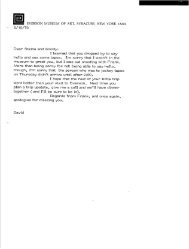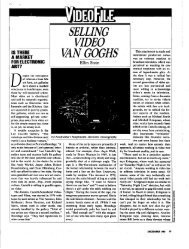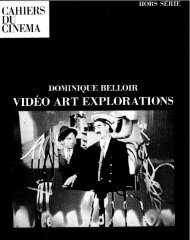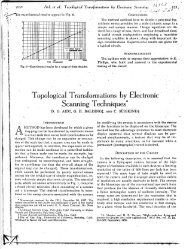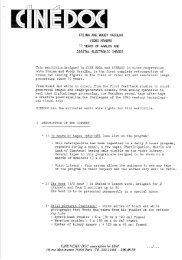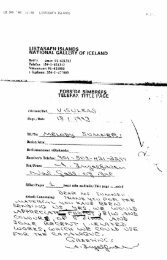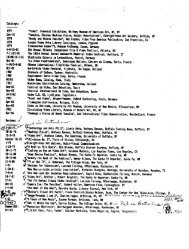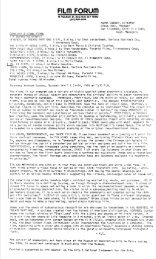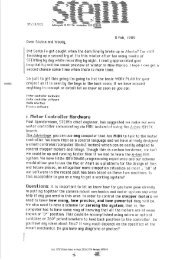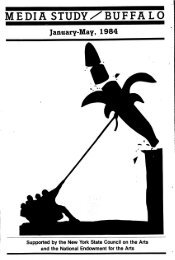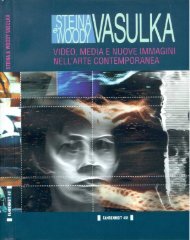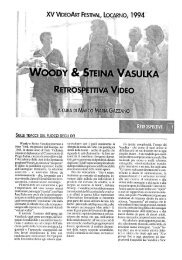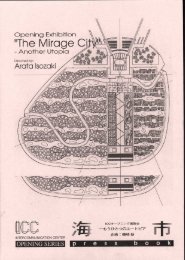Chapter 4: A HISTORY OF COMPUTER ANIMATION ... - Vasulka.org
Chapter 4: A HISTORY OF COMPUTER ANIMATION ... - Vasulka.org
Chapter 4: A HISTORY OF COMPUTER ANIMATION ... - Vasulka.org
Create successful ePaper yourself
Turn your PDF publications into a flip-book with our unique Google optimized e-Paper software.
<strong>Chapter</strong> 4 : A <strong>HISTORY</strong> <strong>OF</strong> <strong>COMPUTER</strong> <strong>ANIMATION</strong> 3/20/92 36<br />
opaque disc with a tiny, backlit hole in it, that it can plot out vector<br />
graphics just as well as a plotter can . But in order to do this<br />
practically one must change their intent-the computerized stand is<br />
no longer thought about as a machine to photograph artwork but as a<br />
line drawing machine . Changing the intent involves changing the<br />
descriptive language of the system, that is, changing the software .<br />
And this represents a major evolution .<br />
Film recorder CRT's<br />
Although IBM provided a a point addressable CRT as an output<br />
option for their 704 computer (1956), the real breakthrough for<br />
computer animation was the introduction, by Stromberg Carlson<br />
Corporation, of the SC-4020, an offline microfilm recorder (1963) .<br />
The SC-4020 included a magnetic tape drive, an instruction set with<br />
vector as well as character capabilities, an addressable screen<br />
resolution of 1024 square, and a camera, which could be a motion<br />
picture camera (fig . 4-64 .5) . SD4020's were purchased by MIT's<br />
Lincoln Labs, Bell Labs, Brooklyn Polytech, and others .<br />
One of the first SC-4020's was purchased by Bell Telephone<br />
Laboratories at Murray Hill, New Jersey, and it helped transform Bell<br />
Labs into one of the centers for early computer animation . The first<br />
computer animated film at Bell was made by Edward Zajac and titled<br />
Simulation of a Two Gyro, Gravity Gradient Attitude Control System<br />
(1963) . The action depicts a wire frame earth satellite in orbit and<br />
shows how the satellite orientation (attitude) changes according to<br />
a mathematical model of the gravity of Earth (fig . 4-65) . Zajac<br />
programmed the film in FORTRAN, computed it on an IBM-7090 and<br />
output to the SC-4020 . It is perhaps the first example of a<br />
scientific visualization, where an animated graphic visualization<br />
displays the solution to an experiment . It was an instant success .<br />
The first pixel animations<br />
The vector graphic drawing of the plotter or the interactive<br />
CRT convincingly simulated pen and ink mechanical drawing, but<br />
what about continuous tone images, like cartoon cels or photographs,<br />
where the image is represented with pixels? It is significant to<br />
65 . Simulation of a Two Gyro Gravity Gradient Attitude Control<br />
System includes dynamic modeling, a perspective camera, and a<br />
clock . A box representing an earth satellite changes orientation<br />
(attitude) according a mathematical model of the gravity of the<br />
Earth . See also Fig . 82 . [Hunt see Halas and Manvelle, Bell, Zajac in<br />
New Scientist 10 Feb 66 or Zajac in Rosebush History or Zajac 1964 .]



